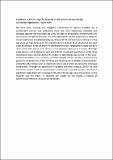Por favor, use este identificador para citar o enlazar a este item:
http://hdl.handle.net/10261/209674COMPARTIR / EXPORTAR:
 SHARE
BASE SHARE
BASE
|
|
| Visualizar otros formatos: MARC | Dublin Core | RDF | ORE | MODS | METS | DIDL | DATACITE | |

| Campo DC | Valor | Lengua/Idioma |
|---|---|---|
| dc.contributor.author | Higginbottom, Gail | - |
| dc.contributor.author | Mom, Vincent | - |
| dc.date.accessioned | 2020-04-29T13:16:07Z | - |
| dc.date.available | 2020-04-29T13:16:07Z | - |
| dc.date.issued | 2019 | - |
| dc.identifier.citation | 47th Computer Applications and Quantitative Methods in Archaeology Annual Conference (2019) | - |
| dc.identifier.uri | http://hdl.handle.net/10261/209674 | - |
| dc.description | Resumen del trabajo presentado a la 47th Computer Applications and Quantitative Methods in Archaeology Annual Conference (CAA) "Check Object Integrity", celebrada en Cracovia (Polonia) del 23 al 26 de abril de 2019. | - |
| dc.description.abstract | We have been studying the megalithic monuments in western Scotland for a considerable peri-od, and uncovering more and more fascinating landscape and skyscape systems that have been set up by the users of these stones to observe the sky and connect the sky and the land. Our prime approaches are the adaptation or adoption of particular forms of statistical analyses, 2D and 3D GIS and immersion software. In the last years we have focused on the standing stones on Mull. Mull, situated at the west coast of Scotland, harbours about 40 standing stone sites, ranging from single stones to short stone rows and to a full stone circle (Lochbuie) made up of 9 stones. Although exact dating is not available for each site on Mull, the general expectation is that these monuments were erected during the middle to late Bronze Age period. In this pres-entation we will focus on Lochbuie, the most complex site on the isle. In particular the geometric arrangements of the Lochbuie site constituents (3 separate standing stones, a Neolithic-EBA kerbed cairn, a small stone and a stone circle) as well as the individual components. Through the application of adapted statistical analyses, 2D/3D GIS and immersion models it will be revealed that Lochbuie was a possible hub for a number of significant solar alignments compared with other Bronze Age sites whose focus, in the majority, was the Moon. To illustrate our results we will include a number of astronomical videos of the Lochbuie landscape. | - |
| dc.language | eng | - |
| dc.relation.isversionof | Postprint | - |
| dc.rights | openAccess | - |
| dc.title | Lochbuie, a Bronze Age focal point of astronomical knowledge | - |
| dc.type | comunicación de congreso | - |
| dc.date.updated | 2020-04-29T13:16:07Z | - |
| dc.relation.csic | Sí | - |
| dc.type.coar | http://purl.org/coar/resource_type/c_5794 | es_ES |
| item.cerifentitytype | Publications | - |
| item.openairecristype | http://purl.org/coar/resource_type/c_18cf | - |
| item.grantfulltext | open | - |
| item.openairetype | comunicación de congreso | - |
| item.fulltext | With Fulltext | - |
| Aparece en las colecciones: | (INCIPIT) Comunicaciones congresos | |
Ficheros en este ítem:
| Fichero | Descripción | Tamaño | Formato | |
|---|---|---|---|---|
| Lochbuie.pdf | 35,17 kB | Adobe PDF |  Visualizar/Abrir |
CORE Recommender
Page view(s)
122
checked on 04-may-2024
Download(s)
89
checked on 04-may-2024
Google ScholarTM
Check
NOTA: Los ítems de Digital.CSIC están protegidos por copyright, con todos los derechos reservados, a menos que se indique lo contrario.
